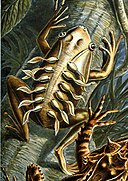Tugna:Haeckel Batrachia.jpg

Tiddi n azaraskan agi : 424 × 599 iferdisen n tugna. Tibuda nniḍen : 170 × 240 iferdisen n tugna | 339 × 480 iferdisen n tugna | 543 × 768 iferdisen n tugna | 724 × 1 024 iferdisen n tugna | 2 323 × 3 284 iferdisen n tugna.
Afaylu aneṣli (2 323 × 3 284 pixel, tiddi n ufaylu: 2,17 MB/MO, anaw n MIME: image/jpeg)
Amazray n ufaylu
Senned ɣef yiwen azmez d usrag iwakken ad ẓṛeḍ afaylu aken yella deg imir nni.
| Azemz/Ssaɛa | Aqmamaḍ | Iseggiwen | Amseqdac | Awennit | |
|---|---|---|---|---|---|
| Lux a | 24 Fuṛaṛ 2006 à 03:17 |  | 2 323 × 3 284 (2,17 MB/MO) | Ragesoss | improve version, based on same original scan |
| 11 Fuṛaṛ 2006 à 00:22 |  | 2 318 × 3 280 (2,21 MB/MO) | Ragesoss | The 68th plate from Ernst Haeckel's 1899 ''Kunstformen der Natur'', depicting frogs classified as Batrachia. Category:Ernst Haeckel |
Aseqdec n ufaylu
Ulaḥedd seg isebtar sɛan azday ar afaylu-agi.
Aseqdec n ufaylu amatu
Iwikiyen-agi-nniḍen seqdacen afaylu-agi:
- Aseqdec ɣef arz.wikipedia.org
- Aseqdec ɣef ast.wikipedia.org
- Aseqdec ɣef az.wikipedia.org
- Aseqdec ɣef ban.wikipedia.org
- Aseqdec ɣef be.wikipedia.org
- Aseqdec ɣef bg.wikipedia.org
- Aseqdec ɣef ca.wikipedia.org
- Aseqdec ɣef ca.wikibooks.org
- Aseqdec ɣef ceb.wikipedia.org
- Aseqdec ɣef ckb.wikipedia.org
- Aseqdec ɣef dag.wikipedia.org
- Aseqdec ɣef de.wikipedia.org
- Aseqdec ɣef din.wikipedia.org
- Aseqdec ɣef el.wikipedia.org
- Aseqdec ɣef en.wikipedia.org
- Wikipedia:Featured pictures thumbs/04
- Wikipedia:Picture of the day/June 2006
- User:Ragesoss/Haeckel
- Wikipedia:Featured picture candidates/Haeckel Batrachia.jpg
- Wikipedia:Wikipedia Signpost/2006-03-13/Features and admins
- Wikipedia:Featured picture candidates/March-2006
- Talk:Frog/Archive 3
- User talk:Ragesoss/Archive1
- Wikipedia:Picture of the day/June 12, 2006
- Wikipedia:POTD/June 12, 2006
- Wikipedia:POTD column/June 12, 2006
- Wikipedia:POTD row/June 12, 2006
- Kunstformen der Natur
- User:Samsara/Frog/Stable
- User:RichardF/POTD
- Wikipedia:WikiProject Germany/Gallery
- User talk:RichardF
- User:Froggyyes~enwiki
- Wikipedia:Featured pictures/Animals/Amphibians
- Unclean spirit
- User:Xophist/s5
- Wikipedia:Wikipedia Signpost/2006-03-13/SPV
- Talk:Alfred Russel Wallace/Archive 1
- Portal:Amphibians/Selected picture
- User:The Transhumanist/Sandbox144
Wali l’utilisation globale n ufaylu-agi.






